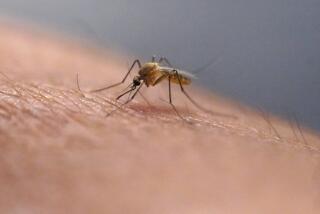SPECIAL ISSUE: SPRING HOME & GARDEN GUIDE : Warmer Days Ahead Will Heat Up Bug Problems Inside Homes
- Share via
Spring is on the way, and for sun-worshiping Southern California that means longer, warmer days--and more bugs.
“Insects, being cold-blooded animals, are pretty much dictated to by the temperatures,” said Fred Beams, assistant manager of the Orange County Vector Control District. “Generally speaking, as the ground warms up and the air warms up, insects get more active, and they’re a lot more likely to come into the house.”
Leading the warm-weather invasion, especially for pet owners, are fleas. The tiny insects cannot breed or survive without human or animal blood, so it doesn’t take long for owners of flea-infested homes to feel their presence. Fleas will bite humans in addition to domestic animals.
Warm weather can also signal an open-house invitation to ants, carpet beetles, crickets, silverfish and roaches. In fact, the Vector Control folks distribute pest control bulletins detailing more than 20 critters that commonly plague county residents. (The bulletins may be obtained by calling the district at (714) 971-2421.)
There are a few general measures that besieged homeowners can take in anticipation of the warm days ahead. Checking to see if all screens are in good repair is a good step, as is making sure to keep all unscreened doors and windows closed.
Cleanliness is an important safeguard, especially in the kitchen. All food products should be securely stored, and counters should be kept clean of crumbs and other food residue that might attract pests. Pet owners should be careful to regularly vacuum areas frequented by their animals.
Pesticides can be helpful in the fight against specific pest problems, but users should exercise caution. First, the label should be read carefully before purchase to make sure the pesticide works on the targeted pest (different chemicals work on different bugs).
Instructions should be followed to the letter. Misuse of pesticides is not only unsafe but can be counterproductive. If too much is used, for example, “you’re much more likely to develop a resistance in the insects you’re trying to eliminate,” Beams said.
The Vector Control District also advises insecticide users to take these precautions: Do not use insecticides around an open flame or exposed foods; clean food preparation areas after the use of pesticides; store out of reach of children and pets, preferably in locked cabinets; never keep pesticides in anything other than the original container, and never reuse the pesticide container to store other materials.
For large problems, professional help might be in order. Vector Control District officials will provide free advice over the phone and will go out to homes when a pest poses a potential health threat. And many private pest control services operate in Orange County, as a glance through the Yellow Pages will show.
For exterminators, business heats up along with the weather. But extermination services are not only a measure of last resort; most companies offer regular maintenance programs to keep specific pests in check.
Following is a list of indoor pests common to the county, and some suggestions from the Orange County Vector Control District on how to keep problems at a minimum:
* Fleas: The female flea lays her eggs on pets; the eggs often fall off and hatch in carpets and other places where the pet spends time indoors. If carpets are not regularly vacuumed, a home may become infested with developing larvae before the infestation is noticed.
If fleas appear in the home, thoroughly vacuum infested rooms, including carpets, rugs and upholstered furniture, and mop uncarpeted areas with a hot soap solution. Fleas can be controlled indoors with several pesticides available at retail stores. Be certain that the solution is non-staining if it is to be used on carpets or fabrics. Treat outside areas where the animal runs or sleeps with sprays of malathion, Sevin, diazinon or Dursban. Cleaning and spraying should be coordinated with flea dips for pets.
* Silverfish: These hardy insects prefer warm, damp, dark places and feed on vegetable matter with a high starch or sugar content, which can include paper and some fabrics. To prevent breeding of these pests, dry out locations that foster their development. Regularly air out and sun stored blankets and clothing.
Solutions such as Ronnel and Dursban can be effective when sprayed on infested surfaces, including attics and basements, closets, baseboards, the shelves and back walls of cabinets and bookcases, under sinks and in holes where pipes pass through walls and floors.
* Carpet beetles: The larvae of these pests feed on anything that contains feathers, wool or fur--and have even developed a taste for many man-made fibers. The larvae are about one-quarter-inch long, elongated and have brownish to black bristles that give them a gray or golden fuzzy appearance. As they develop, they cast off their skins, and this small, fuzzy case is the first sign of an infestation.
Regular vacuuming is the best safeguard against potential infestation, especially in hard-to-reach places such as near the wall. Woolen scraps, pennants or garments that lie for long periods of time may be sources of infestation and should be stored with treated paper. Fumigation may be needed in severe cases of infestation.
* Crickets: Although they usually breed outdoors in uncultivated areas, crickets can become a problem if a nearby vacant lot has been disturbed. They can be a nuisance because of their noise, and because they sometimes chew soiled fabrics.
Seal off cricket entryways by tightening screens and weather-stripping doors and windows. Dusts or sprays can be applied to cracks and other hiding places. Aerosols containing Pyrethrum and silica aerogel drying powder are the safest to use indoors.
* Ants: Although they do not carry disease, ants in the home can be an annoyance. They often get into food supplies, some preferring sweet substances and others feeding on grease.
Locate the ants’ nest, if possible, and treat with insecticide. Also treat all cracks or openings ants use to get into the house. It is best if the ants are controlled in the spring months before their populations increase.
* Cockroaches: Oriental cockroaches are secretive, preferring dark, cool, damp areas such as water meter boxes and dense vegetation along curbsides or foundations. Occasionally they are found in the home, often in the bathtub or shower. This does not mean the home is infested. More likely, it is the result of the roach searching for food away from its nesting area.
Prevention and control of cockroaches require elimination of food sources, which may include pet food, spilled garbage containers or trash cans in poor condition. Piles of lumber or other debris may also provide hiding places for roaches, so general yard cleanup should be performed regularly. It may also be necessary to apply insecticides in places where they breed, such as around the house foundation and nearby thick vegetation. Suitable pesticides include diazinon, Baygon or Dursban.
COMMON HOUSEHOLD PESTS
FLEAS
Description: Tiny, oval, biting insects that lay eggs on pets. Blood of hosts is needed for viable eggs.
Habitat: Can live inside or outside home.
Problem: Eggs often fall into carpets, where they can hatch and infest the home.
Prevention: Regularly vacuum or mop areas frequented by pets. Flea-dip pets when warm weather approaches.
ANTS
Description: Adults vary in size, are generally wingless. Abdomen is restricted (thin-waisted), unlike termites, which are broadly joined at thorax.
Habitat: Social insects found in nests or colonies in open ground, under stones, in wood, etc.
Problem: Often enter house in warm weather, can get into food supplies.
Prevention: If ants appear, treat openings by which they enter home with insecticide. Find nest if possible and treat also.
CARPET BEETLES
Description: Larvae become one-quarter inch long, elongated or oval in shape, have brownish to black bristles. Adult is slightly bigger, broadly oval, and dark; mottled with white, yellow, brown or black.
Habitat: Damaging larvae can be found in carpets, especially along walls and under furniture, and in dark areas of drawers, closets and cupboards.
Problem: Feed on animal hair and man-made fibers.
Prevention: Regular vacuuming is best safeguard. Woolens and other fabrics should be stored with treated paper.
CRICKETS
Description: Fast-moving, hopping, chirping insects; black to brownish and up to 1 inch long.
Habitat: Normally breed outdoors in uncultivated areas; can move indoors when habitat is disturbed, as when land is cleared for houses.
Problem: Noisy, can chew soiled fabrics.
Prevention: Seal off entryways by tightening screens and weather-stripping doors and windows. Dusts or sprays can be applied to cracks and other hiding places.
ORIENTAL COCKROACHES
Description: Dark brown to black, about 1 inch long, long antennae. Females have only traces of wings; males have wings that cover about half of body.
Habitat: Cool, dark, damp areas such as water meter boxes and dense vegetation near house foundations.
Problem: Can enter home in search of food.
Prevention: Good housekeeping. Elimination of food sources, including pet food, spilled garbage containers or trash cans in poor condition.
SILVERFISH
Description: Narrow, tapering, wingless, scaly insects one-third to one-half inch long, with long antennae, three prominent filaments protruding from the tail. Feed on vegetative matter with high starch or sugar content.
Habitat: Prefer warm, damp, dark places.
Problem: Feed on paper and some fabrics.
Prevention: Dry out locations that foster development; regularly air out and place stored blankets and clothing in sun.
Source: Orange County Vector Control District.
More to Read
Sign up for The Wild
We’ll help you find the best places to hike, bike and run, as well as the perfect silent spots for meditation and yoga.
You may occasionally receive promotional content from the Los Angeles Times.






